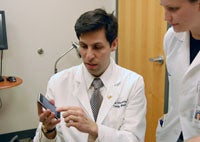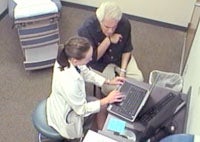The Doctor, Patient – And Computer

Posted in GUMC Stories
 Instead of the relationship of trust between a patient and physician, a third player, if effectively introduced and incorporated in the discussion, can create a “triangle of trust” that might even lead to better health outcomes. That is what instructors in the department of family medicine at Georgetown University School of Medicine are teaching their medical students.
Instead of the relationship of trust between a patient and physician, a third player, if effectively introduced and incorporated in the discussion, can create a “triangle of trust” that might even lead to better health outcomes. That is what instructors in the department of family medicine at Georgetown University School of Medicine are teaching their medical students.
Most physicians are now familiar with that third player: a laptop or other piece of technology that a physician can consult to look up a patient’s electronic health record (EHR). Use of EHRs is quickly on the rise: almost half of primary care physician offices in the country already have them, and they are expected to be in a majority of hospitals within five years, says Steven Schwartz, M.D., F.A.A.F.P., associate dean for informatics and associate professor of family medicine.
EHRs, online prescribing and medical information are great resources, especially to new doctors, he says. But the use of the devices and their information can also be terribly distracting to the doctor in an exam room and often distressing to the patient, who doesn’t feel cared for, Schwartz adds.
That’s why the department of family medicine launched a novel effort last year to teach Georgetown medical students how to use technology effectively in a clinical setting.
Takes a “lot of practice”
Take the example of what can go wrong, as seen in a videotape of an encounter with a 3rd year medical student and an actor playing a ”patient” with diabetes. The student sits at a desk, looking into a computer. The student talks haltingly — and then not at all — while reading information on the screen. The patient sits, neglected, looking away and sighs.
Another 3rd year medical student, Erika Runge, was a little more experienced during her “patient encounter”, which was part of the Family Medicine Clerkship’s Objective Structured Clinical Examination (OSCE). Third year medical students, who rotate through different clinical specialties and disciplines, take the OSCE – a test of communication skills – during their four weeks in the family medicine clerkship.
 After shaking the same patient’s hand, Erika asks him to move from the exam table to a chair next to her so they could jointly look at and discuss the laboratory test results displayed on her laptop. She moves the laptop table between them, and the triangle of trust is formed. Erika stops peering into the laptop from time to time to look, smile and talk directly with the patient.
After shaking the same patient’s hand, Erika asks him to move from the exam table to a chair next to her so they could jointly look at and discuss the laboratory test results displayed on her laptop. She moves the laptop table between them, and the triangle of trust is formed. Erika stops peering into the laptop from time to time to look, smile and talk directly with the patient.
Erika became familiar with using EHRs when she worked at a doctor’s office, as part of her clerkship. “It takes a lot of practice to work this triangle effectively,” she says. “If a sensitive topic comes up, you need to take your hands off the laptop, and just talk with the patient.”
She adds that most of the real patients, at the medical practice where she clerked, felt comfortable with EHRs as the third player. Many patients even said it was great to have all that information at hand because they couldn’t remember the specifics of their previous care or their medications.
“You just need to know how to incorporate it [the laptop] into the encounter,” Erika says.
Motivational communications
The use of EHRs can “engage patients more in shared decision making,” says Schwartz, which is a theme that runs throughout the OSCE exam. “When done well, use of electronics can enhance a patient’s experience because the patient becomes more involved in their own care, he adds, “They see the labs, they understand what they mean, and help in the treatment plan.”
Vincent WinklerPrins, M.D., F.A.A.F.P., the family medicine clerkship director, says one of the key teaching efforts in the month-long clerkship is motivational interviewing — interaction between a physician and patient that is designed to enact behavioral change. “One of the most challenging things we face as physicians is working with people who are trying to change behaviors that may be adverse to their health,” WinklerPrins says.
“The problem is how do you make it personal? Because behavior change is very personal and what works for one person may not work for another. For physicians, just being smart and knowing the right answers rarely changes peoples’ behaviors,” he says.
“And so you have to know how to engage [patients] in a communication style that’s much more effective and that’s helping them be more engaged with their health so that they realize they have real choices they can make that can carry real consequences for their lives,” says WinklerPrins. “It’s all about giving patients their sense of control back.”
Maintaining focus on the conversation
WinklerPrins has been at Georgetown for a year, and he says that one of the things that sets apart this communications skills program from others is the use of the patient simulating experience with actors. This allows the students to gain personalized feedback from the actors. And, the experience is videotaped so that the students can view their interactions.
Schwartz, along with Caroline Wellbery, M.D., an associate professor in the department of family medicine, and others, deserve all the credit, WinklerPrins says. While Schwartz focuses on a student doctor’s interaction with technology, Wellbery developed a simulated experience, using motivational interviewing, and assessment. She says that when she put the OSCE together, she couldn’t find anything like this at other medical schools. Unlike what others were doing, her OSCE focuses more on the conversation, not just the physical exam, Wellbery says.
“Some medical students are a little resistant to this style, because they may have been trained in more of a dictatorial style,” she says. “[And, will be] frustrated at times with patients who don’t do what is best for them.”
Wellbery says she will reserve judgment about how well computers can be incorporated into the doctor-patient relationship. “We are trying to blend two disparate worlds — the relationship world in which a physician is deeply engaged with a patient’s concerns, and the highly technical world of data entry and retrieval.
“I know this is the coming reality,” she says. “But I think it will be a challenge in practice.”
By Renee Twombly, GUMC Communications
(Published January 25, 2012)
